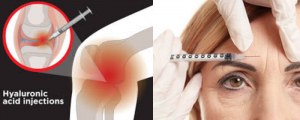How to Choose the Right Injectable-Grade Hyaluronic Acid
Hyaluronic acid is a naturally occurring ingredient in the human body, known for its excellent moisturizing, lubrication, and biocompatibility. These merits have led to a wide variety of applications in medicine and cosmetics.
According to its purpose, HA can be divided into cosmetic-grade, food-grade, medical-grade, and injectable-grade. Of them, injectable-grade HA is extensively used in cosmetic surgery, joint therapy, and medical lubrication. How to choose suitable injectable-grade HA according to the particular requirement? Let’s discuss that.
What is Injectable-Grade Hyaluronic Acid
Injection-grade hyaluronic acid represents high-quality HA developed especially for medical and cosmetic injection purposes. It undergoes extensive purification processes to remove impurities and possible allergens, ensuring the following features:
- High Purity: It is of medical-grade quality, thus safe to be injected.
- High Biocompatibility: Very similar in structure to human tissues for maximum safety.
- Long-Lasting Stability: It degrades much more slowly, prolonging its effect.
This kind of HA is used for filling facial hollows, and lubricating joints, and can even enhance the smooth operation of surgical tools.
Key Considerations When Choosing Injectable-Grade Hyaluronic Acid
The key to selecting the right injectable-grade HA lies in understanding your application needs. Of course, we have summarized some core indicators here to help you understand your needs.
- Molecular Weight
Molecular weight defines the viscoelasticity, absorption rate, and degradation time of HA. Generally speaking, high molecular weight works better for lubrication and support, while low to medium molecular weight serves for penetration and drug delivery.
- Purity and Sterility
HA injections should have ultra-high purity, be free from impurities, and be manufactured under sterile conditions to minimize infection risk.
- Biocompatibility
Good quality HA should be strictly tested for compatibility with human tissues to minimize inflammation or adverse reactions upon its use.
- Certification and Credentials
Only choose products certified by international authorities such as FDA or CE to ensure good quality and safety.
Products meeting this criterion will perform well in the intended applications.
Read more: How is Hyaluronic Acid Powder Made
Suitable Molecular Weights for Different Scenarios
–Cosmetic Procedures
HA is commonly used in cosmetic procedures to fill facial hollows, reduce fine lines, and improve skin elasticity.
| Recommended Molecular Weight | Medium to high (1,300 kDa–1,800 kDa) |
| Features | Strong viscoelasticity and good support, capable of sculpting natural facial contours with prolonged effects. |
| Typical Applications | Nose augmentation, facial fillers, and lip shaping |
Studies have shown that HA with molecular weights in the range of 1,300 kDa–1,800 kDa provides optimal viscoelasticity and volumizing effects, which are crucial for facial contouring and dermal filler applications.[i]
The medium to high molecular weight provides the structural integrity needed to sculpt facial contours while maintaining biocompatibility and longer-lasting effects due to slower degradation rates.
–Joint Injections
For patients with osteoarthritis, HA injections are essential for pain relief and improved joint mobility.
| Recommended Molecular Weight | High (>1,800 kDa) |
| Features | High viscosity and excellent lubrication to absorb shock during joint movement, reducing inflammation and pain |
| Typical Applications | Injections into knee and hip joints |
The high molecular weight ensures a thick, viscous solution capable of providing cushioning for joints, mimicking natural synovial fluid.
–Medical Lubricants
HA is often used as a lubricant during surgical procedures to minimize friction between instruments and tissues, improving procedural efficiency.
| Recommended Molecular Weight | Medium (800 kDa–1,300 kDa) |
| Features | Balanced flowability and lubrication, reducing friction while maintaining high safety standards |
| Typical Applications | Coating for catheters and aiding endoscopic operations |
Medium molecular weight (800 kDa–1,300 kDa) HA is well-documented for its flowability and lubricating properties, essential for reducing friction during surgical procedures.[ii]
Medium molecular weight strikes a balance between being easy to handle and highly effective as a lubricant, making it suitable for surgical applications requiring precise, smooth interactions.
Conclusion
It is easy to select the proper injectable-grade hyaluronic acid once the application scenario is clear. Cosmetic procedures require medium and high molecular weight products for excellent support and longevity of results. High molecular weight HA has better application in joint injections, as it maintains lubrication and cushioning.
Meanwhile, in medical lubricant applications, medium molecular weight HA remains flowable with safety features. Regardless of the application, always prioritize purity, sterility, and certifications to ensure safety and effectiveness.
Pure Injection Hyaluronic Acid (HA) Powder from Stanford Chemicals Company
Injection-grade hyaluronic acid from Stanford Chemicals Company (SCC) is GMP, CEP, and DMF certificated and the factory passed an on-site inspection by the US FDA. It is all fermented products, non-animal sources, non-GMO, and non-BSE/TSE risk.
Main Products:
| Item No. | Specification |
| HA-EP1.8-SC | M.W: 800K-1,300K Da,
I.V.: 1.44-2.12 m3/kg |
| HA-EP2.4-SC | M.W: 1,300K-1,800K Da;
I.V: 2.12-2.72 m3/kg |
| HA-EP3.0-SC | M.W:1,800K-2,500K Da;
I.V.: 2.72-3.53 m3/kg |
| HA-EPC-SC | Customized Molecular weight |
References:
The 5 Common Uses of Injectable Hyaluronic Acid
High vs. Low Hyaluronic Acid: How Molecular Weight Affects the Efficacy
[i] Kablik J, Monheit GD, Yu L, Chang G, Gershkovich J. Comparative physical properties of hyaluronic acid dermal fillers. Dermatol Surg. 2009 Feb;35 Suppl 1:302-12. doi: 10.1111/j.1524-4725.2008.01046.x. PMID: 19207319.
[ii] Cowman MK, Schmidt TA, Raghavan P, Stecco A. Viscoelastic Properties of Hyaluronan in Physiological Conditions. F1000Res. 2015 Aug 25;4:622. doi: 10.12688/f1000research.6885.1. PMID: 26594344; PMCID: PMC4648226.

